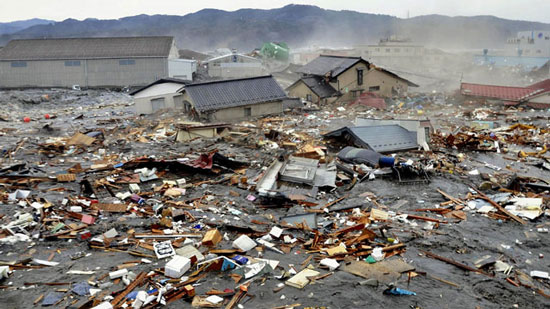Japanese tsunami broke the Antarctic ice
The tsunami on March 11 in Japan was so powerful that it broke many large blocks of ice in Antarctica, a few thousand kilometers from Japan.
As soon as the tsunami from the Pacific Ocean hit the northeastern coast of Japan on March 11, Kelly Brunt, a scientist at the Goddard Space Flight Center in the US, and colleagues used photos from satellite to observe the southernmost part of the earth.
"As soon as the earthquake in Japan happened we knew that it would be one of the strongest earthquakes in modern history," Brunt said.

The impact of the March 11 tsunami in Japan reaches the Antarctic.
According to Brunt, after the Pacific bottom earthquake caused huge waves from the epicenter. Those waves move toward an ice shelf in Antarctica, about 13,600 kilometers from the epicenter. About 18 hours after the earthquake occurred, waves breaking many ice blocks had a total area equal to twice the surface area of Manhattan, New York City and the United States (more than 64 km2). According to historical documents, the ice block did not budge for 46 years before the tsunami appeared.
The ice in the sea in front of the Sulzberger ice shelf almost disappeared at the time of the tsunami. Scientists believe that ice on the sea surface reduces the power of tsunamis. By the time the tsunami struck Indonesia's Sumatra island in 2004, the waves could not reach Antarctica due to entanglement of icebergs. In the case of Sulzberger ice shelf, the disappearance of the ice on the bay made the tsunami reach it easily.
Previously, the scientific community had seen ice blocks break because of earthquakes. But this is the first time someone has found them broken because of the tsunami.
- A series of 'tsunamis' broke out on the sun
- 'Scar' in the heart of Japanese tsunami victims
- The strange effects of Japanese earthquakes
- Japanese tsunami system focused on evacuating people
- The Japanese are afraid of the 'black tsunami' coming soon
- Tsunami in 2011 brought millions of creatures from Japan to the US coast
- Japanese tsunami landed on Alaska
- Discovering the 'massive' iceberg in Antarctica
- Again a fire in the Japanese nuclear plant, the danger increased
- Japanese inspired double tsunami in March
- Japanese earthquake / tsunami: Looking back at the numbers
- Photo reporter miraculously survived the tsunami
 Is the magnetic North Pole shift dangerous to humanity?
Is the magnetic North Pole shift dangerous to humanity? Washington legalizes the recycling of human bodies into fertilizer
Washington legalizes the recycling of human bodies into fertilizer Lightning stone - the mysterious guest
Lightning stone - the mysterious guest Stunned by the mysterious sunset, strange appearance
Stunned by the mysterious sunset, strange appearance